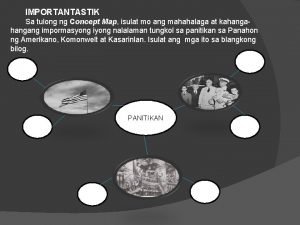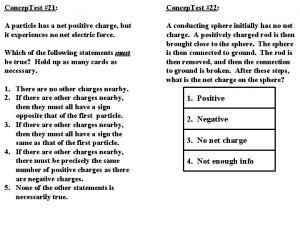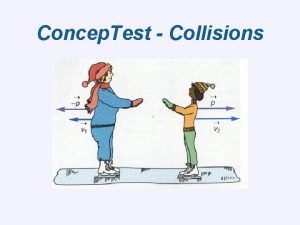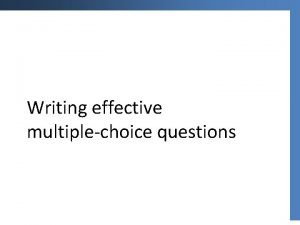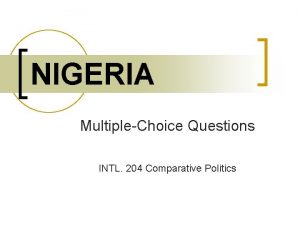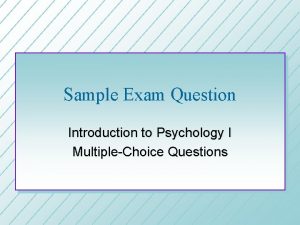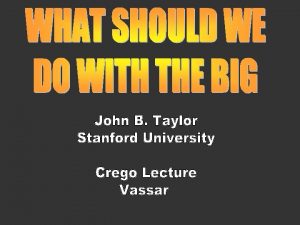Concep Test What it is Multiplechoice question that







- Slides: 7

Concep. Test What it is: Multiple-choice question that focuses on one key concept of the lesson. Implementation: • Present a short lecture (5 -10’) • Post a Concep. Test on board/screen • Students consider question and answer (by hands, lettered cards, clickers…) • Students discuss reasons for their answers with neighbors • Students answer question again • Instructor, or student spokesperson, explains the correct response The question should: • Focus on application of a single concept (not recognize a fact or define a term) • Be of intermediate difficulty (expect 35 -70% of student to initially answer correctly) Concep. Tests have been shown to: • Increase student engagement • Communicate high expectations • Promote interaction • Provide prompt feedback • Increase student course satisfaction • Improve student attendance • Improve student learning Examples Mc. Connell, D. A. , et al. , 2006, Journal of Geoscience Education, v. 54, #1, p. 61 -68. Mc. Connell et al. , 2006 The following diagram illustrates the hydrologic cycle. Arrow 11 best represents what process? a. evaporation b. precipitation c. transpiration d. run-off http: //serc. carleton. edu/introgeo/conceptests/examples/hydro_cycle 11. html Designed by Rachel Beane, Bowdoin College On the Cutting Edge project Information and examples from http: serc. carleton. edu/introgeo/conceptests/index. html References Beatty, I. D. , Gerace, W. J. , Leonard, W. J. , & Dufresne, R. J. (2006). Designing effective questions for classroom response system teaching. American Journal of Physics, 74 (1), 31 -39. Greer, L. & Heaney, P. J. (2004). Real-time analysis of student comprehension: An assessment of electronic student response technology in an introductory Earth Science course. Journal of Geoscience Education, 52(4), 345 -352. Mc. Connell, D. A. , Steer, D. N. , Owens, K. D. , Knott, J. R. , Van Horn, S. , Borowski, W. , Dick, J. , Foos, A. , Malone, M. Mc. Grew, H. , Greer, L, & Heaney, P. J. (2006). Using Concep. Tests to assess and improve student conceptual understanding in introductory geoscience courses. Journal of Geoscience Education, 54 (1), 61 -68. Smith, M. K. , Wood, W. B. , Adams, W. K. , Wieman, C. , Knight, J. K. , Guild, N. , & Su, T. T. (2009). Why peer discussion improves student performance on in-class concept questions. Science, 323, 122 -124.

Cooperative Exam What it is: Exams for which students answer some questions independently and some in groups. These type of exams may be called cooperative, two-stage, or pyramid exams. Implementation: • Prepare an exam that has an individual component and a cooperative group component. • Questions may be in any format: multiple choice, short answer, problem-solving… Questions in the 2 nd part may build on a questions from the 1 st part or ask them in a new way. • For the 1 st part of the exam (often 30 -45’), students individually answer questions and turn in their responses. • For the 2 nd part of the exam (often 30 -45’), in groups of 3 -5, students answer the same questions, new questions, or a combination of both depending on how you choose to format the exam. Photo by Mark Leckie Student comments: (from Wieman et al. , 2014) • I was able to instantly learn from my mistakes. • It was good to compare methods and answers with others, and it allowed us to be more confident. • Interesting. All had different ways of approaching the question. Very helpful to understand everyone’s response and why they thought their answer was correct. References Grading: • Many instructors have the individual component count as 70 -80% of the total exam grade, with the cooperative portion counting for the remaining. • Many instructors do not penalize students if they perform better on the individual portion than on the cooperative portion. Cohen, D. & Henle, J. (1995). The Pyramid Exam, . In Undergraduate Mathematics Trends, MAA. Advantages: • Exam is a learning experience • Immediate feedback from peers • Students achieve a higher level of mastery Zipp, J. (2007). Learning by Exams: The Impact of Two-Stage Cooperative Tests. Teaching Sociology, 35, 62 -76. National Association of Geoscience Teachers. Cooperative Exams. Teach the Earth. https: //serc. carleton. edu/46286. Wieman, C. , Rieger, G. , & Heiner, C. (2014). Physics Exams that Promote Collaborative Learning. The Physics Teacher, 52, 51 -53. Yuretich, R. , Khan, S. , Leckie, R. M. , & Clement, J. (2001). Active. Learning Methods to Improve Student Performance and Scientific Interest in a Large Introductory Oceanography Course. Journal of Geoscience Education, 49, 111 -119. Designed by Rachel Beane, Bowdoin College On the Cutting Edge project Information from https: //serc. carleton. edu/NAGTWorkshops/earlycareer 2010/cooperative_exams. html

5 1 4 2 Gallery Walk 3 What it is: Students get out of their seats and respond in small groups to a prompt, and then respond to other student’s responses as well. Implementation: • Instructor posts a series of prompts around room. Prompts should be open-ended, allowing for a variety of responses. • Provide instructions to students and arrange students into groups • Each group responds on paper to one of the prompts. • Groups rotate through prompts, responding both to the prompt as well as prior groups’ comments. Instructor monitors and spurs discussion when needed. • Students report out key points. Instructor adds comments and corrects for misconceptions. Benefits: • Facilitates student interaction & collaboration • Allows all students to voice their thoughts • Promotes debate and consensus building • May be used to assess students’ prior knowledge or misconceptions • Wakes up students with movement Example prompts: • Images • Graphs • News headlines • Opinion statements • Questions Group members may choose roles: • Leader • Reporter • Monitor • Recorder Gallery Walk introducing REE in 30 person, non-majors course. Photo by Kevin Travers, Bowdoin College. Examples of Gallery Walk questions organized by Bloom’s Hierarchy • Knowledge: List the impacts of increased ultraviolet radiation reaching the earth. • Comprehension: What is the difference between weathering and erosion? • Application: Use Darcy’s Law to calculate groundwater flow rates in the marked locations. • Analysis: What inference can you make about the geomorphic history of this region based on the terraces? • Synthesis: Create a coastal zoning plan to better protect from hurricane damage. • Evaluation: Use scientific evidence to defend or criticize the use of Yucca Mountain as a nuclear waste repository. Designed by Rachel Beane, Bowdoin College On the Cutting Edge project Information and examples from Francek, M. Gallery Walks. Starting Point Teaching Entry Level Geoscience. http: //serc. carleton. edu/introgeo/gallerywalk/index. html

Jigsaw What it is: Cooperative learning during which students first become experts in one aspect, then peer-teach and work together to solve a problem or complete a task. Implementation: • Instructor divides topic into team assignments • In teams, students become experts (through an assignment) on one aspect • Students recombine, with each team represented in the new group • Students in the group, first teach other their specialties, then work together to solve a problem or complete a task. The topic/problem should: • Be easy to divide • Have related team assignments • Not require students to be experts in everything • Be complex enough to result in productive discussions Puzzle graphics by Barbara Tewksbury, with background ASTER image from NASA/GSFC/METI/ERSDAC/JAROS, and U. S. /Japan ASTER Science Team Example: Google Earth. Each team analyzes different locations that show similar features (e. g. , barrier islands, folds, valley glaciers, volcanic cones, etc. ), then combine to discuss similarities and differences of the feature. Example: Plate tectonics. Teams analyze earthquake, volcano, seafloor age, and topography data maps, then combine to draw plate boundaries and interpret processes. Designed by Rachel Beane, Bowdoin College On the Cutting Edge project Information, photos, graphics, and examples from Tewksbury, B. , Jigsaws. Starting Point Teaching Entry Level Geoscience. http: //serc. carleton. edu/introgeo/jigsaws/index. html.

Minute Paper What it is: Questions that require short responses from students. The “Minute Paper” is sometimes called “Muddiest Point” or “Daily Check-In” depending on how it is used. Implementation: • Pose a question. • Students respond May be anonymous. May be collected on notecards. • Collect responses and review Read with an open mind. You may learn students are unsure about a concept you believe was explained clearly. • Address student responses You may choose to do this at the start of the next lesson or electronically via email or a class website Advantages: • Provides immediate feedback • Students self-assess: they must mentally review before they can respond • Facilitates student reflection which increases retention • Allows all students to have a “voice” in the class Examples of common questions: • What was the most important point discussed in today’s class? • What question do you have about today’s class/reading/discussion? • What was the muddiest point in today’s class? • What would you like to learn more about? More examples and information at http: //serc. carleton. edu/introgeo/interactive/oneminwrite. html References Almer, E. D. , Jones, K. , & Moeckel, C. (1998). The Impact of One. Minute Papers on Learning in an Introductory Accounting Class. Issues in Accounting Education, 13, 485 -497. Angelo, T. A. & Cross, K. P. (1993). Classroom assessment techniques: A handbook for college teachers. 2 nd edition. San Francisco: Jossey-Bass Publishers, p. 148 -153. Chizmar, J. F. & Ostrosky, A. L. (1998). The One-Minute Paper: Some Empirical Findings. Journal of Economic Education, 29, 310. National Association of Geoscience Teachers. One-Minute Write. Starting Point Teaching Entry Level Geoscience. http: //serc. carleton. edu/introgeo/interactive/oneminwrite. html Stead, D. R. (2005). A review of the one-minute paper. Active Learning in Higher Education, 6, 118 -131. Designed by Rachel Beane, Bowdoin College On the Cutting Edge project

Think-Pair-Share What it is: A thought-provoking question is posed to students who think about the answer then discuss it with their neighbors. Implementation: • Ask a question • Students think about or write down their answer (usually 1 -2 minutes) • Students pair up • Students share their thoughts with each other and discuss the answer • Instructor can ask for responses from some, all, or no pairs The question: • Promotes student engagement • Facilitates informal assessment Think individually Examples include • Image Interpretation: Interpret the geologic history of the rocks shown in this image. • Graph Interpretation: From the plot of weathering depth vs. age for limestone in tombstones, estimate the mean weathering rate. • Open-ended question: How do we know what the climate was like before people started keeping track? • More examples at: http: //serc. carleton. edu/16225 Form small groups & discuss Share with larger group References King, A. (1993). From Sage on the Stage to Guide on the Side. College Teaching, 41, 30 -35. Lyman, F. (1987) Think-Pair-Share: An expanding teaching technique. MAA-CIE Cooperative News, 1, 1 -2. Starting Point. Think-Pair-Share. Teaching Entry Level Geoscience. http: //serc. carleton. edu/introgeo/interactive/tpshare. html Designed by Rachel Beane, Bowdoin College On the Cutting Edge project

Plan Wrapper Adapt Monitor Exam Wrapper What it is: a self-monitoring activity that surrounds another assignment or activity. 3 steps to teach metacognition: (Lovett, 2008) 1. Teach students their ability to learn can change. 2. Teach planning and goal-setting. 3. Provide opportunities for students to monitor and adapt their learning. Wrapper benefits: • Students monitor their learning. • Students get immediate self-feedback. • Responses to wrapper may provide start to in -class discussion. • Big impact for a short activity. Lecture Wrapper (Lovett, 2008) v Start of lecture: provide tips on active listening v End of lecture: students list 3 key points of lecture. Instructor collects lists, and reveals 3 most important points for immediate feedback. v Study: After 3 successive lecture wrappers, student responses increasingly matched the instructor's: 45%, 68%, 75%. Research Project Wrapper ² ² What did you learn about research and the topic through this project? What did you learn about your own research habits and preferences? When were you excited or frustrated during the project? If you did a similar project in the future, would you approach the project the same or differently? (modified from Ambrose et al. , 2010) 1. Approximately how much time did you spend preparing for this exam? 2. What percentage of your time was doing the following: a. Reading textbook sections for the first time b. Rereading textbook sections c. Practicing problems d. Reviewing notes e. Reviewing class materials f. Other (specify) 3. After reviewing your graded exam, estimate the percentage of points lost due to the following: a. b. c. d. Lack of understanding the concept Not knowing how to approach the question/problem Carelessness Other 4. Based on your responses above, how do you plan to prepare differently for the next exam? Reading Reflection (Wirth & Perkins, 2008) ² ² ² What is the main point of this reading? What did you find surprising? Why? What did you find confusing? Why? References Ambrose, S. A. , Bridges, M. W. , Di. Pietro, M. , Lovett, M. C. , Norman, M. K. & Mayer, R. E. (2010). How learning works: Seven Research Based Principles for Smart Teaching. San Francisco, CA: Jossey Bass. Lovett, M. C. (2008). Teaching Metacognition. Presentation to the Educause Learning Initiative Annual Meeting. National Association of Geoscience Teachers. The Role of Metacognition in Teaching Geoscience. Teach the Earth. http: //serc. carleton. edu/NAGTWorkshops/metacognition/index. html Wirth, K. R. , and Perkins, D. , 2008, Learning to Learn. http: //www. montana. edu/rmaher/barrier_courses/Learning%20 to%20 Learn%20 Wirth. pdf Designed by Rachel Beane, Bowdoin College On the Cutting Edge project
